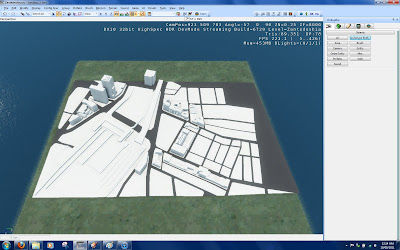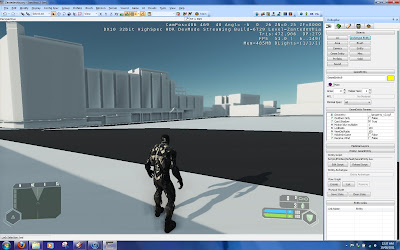A major hurdle is the transition from a program like revit which operates in orthographic drawing modes to create a three dimensional model (plan/section/elevation) into a program like Crysis where you are modelling from a first person perspective. It can be difficult to align things or navigate quickly when you are in the first person perspective. The more I use the software the more I get used to it.
Another problem I have encountered is a glitch in the software when running in Windows 7 on a 32-bit machine which results in the co-ordinates not being visible (a useful tool for aligning models with one another in lieu of orthographic views). I have just bought a new HP laptop which is a 64-bit machine so this will soon not be an issue.
The Crysis engine has a polygon limit which is only going to become more and more of an obstacle the further I get into this project. This means that when importing models that have lots of polygons (surfaces) I will have to split the model into multiple parts. I spent some time investigating what the poly limit is. By a process of trial and error I think the max no. of polys is somewhere between 1200 and 1300. This isnt too much of a headache now that I know the limit as sketchup tells me how many surfaces my model has before I try to export it into Crysis.
Another problem is texture mapping. I am already aware that my sketchup models can only have one material assigned to them. Different parts of the model of varying materials have to be imported as individual models so that I can assign them each a different material. Also I will have to create my own texture files as when trying to assign the existing Crysis textures to my geometry, they seem to be very glitchy, either not appearing or being at a very minute scaling. I have yet to figure out how to adjust the scale of a texture in the material editor in Crysis.
I first attempted to model a context model of the subject site (Centennial Plaza) in Crysis but the tools for generating terrain are not well suited to creating accurate topography. For this reason I decided to import the topography as a geometric entity and place it over a flat terrain.
Below are some images so far of my context model. I began with a flat site and then imported the roads, topography and surrounding buildings. I have yet to decide if I will leave the context model as abstract in form and colour or if I will go for a realistic look with street lights, cars, etc. Texture mapping the surrounding buildings would be extremely time consuming and not worth the effort. Instead I may focus on getting some geometry into the model of an even broader context so that it gives the real impression of being in the Centennial Plaza setting (at the moment you can see the grass and ocean beyond the buildings).
The 'base' of the model

Importing the roads and property boundary models

After importing the surrounding buildings

View from street level (Elizabeth St looking North East)
